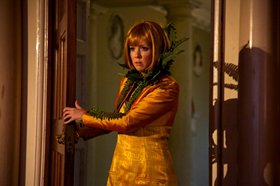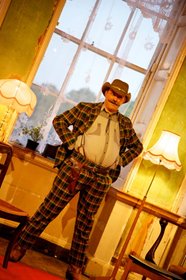The formidable Crawford MacPherson (Clare Barrett) arrives at Póg mo Thóin Hall by car, greeted by nervous Tim Hartigan (Malcolm Adams), taking instruction from MacPherson’s husband, absent estate-owner Ned Hoolihan (Louis Lovett), to accommodate her. MacPherson has a plan. She intends to rid Ireland of its indolence and licentiousness by banishing the potato. She intends to introduce a system of irrigation and share-cropping around the cultivation of sago, a tropical plant that produces edible gloopy starch. At the nearby Baggeley Hall, a dopey handyman (Lovett again) works against the decay of the building to build a casino for the dotty and dope-addicted Imperial hangover Dr. Eustace Baggeley (Lovett again, bless him). Baggeley’s house-man is one Sarsfield Slattery (Darragh Kelly), a cheeky and resourceful character clad in a green suit, with  red hair and shiny cheeks that make him seem for all the world like a Leprechaun: and maybe he is. MacPherson takes an instant dislike to Slattery. Why? Does it have anything to do with her plan for the reform of Ireland? Who is that girl (Lisa Lambe) that keeps avoiding contact with the other characters, and why can we hear the sound of typing?
red hair and shiny cheeks that make him seem for all the world like a Leprechaun: and maybe he is. MacPherson takes an instant dislike to Slattery. Why? Does it have anything to do with her plan for the reform of Ireland? Who is that girl (Lisa Lambe) that keeps avoiding contact with the other characters, and why can we hear the sound of typing?
Slattery’s Sago Saga is a game of two halves played by two authors, one of whom has the unfair advantage of being alive. Arthur Riordan, whose Improbable Frequency remains one of the highpoints of a new satirical/absurdist Irish theatre, has taken Flann O’Brien’s unfinished novel and run with it to a playfully reflexive conclusion. As O’Brien runs out of story due to a slight case of death, Riordan asserts a reflexive meta-text in which the characters become aware of their fictional status. The struggle for the soul of 1960s Ireland becomes a battle for control of the 21st century writing that determines their behaviour. It’s Pirandello, John Dickson Carr, Monty Python, The League of Gentlemen’s Apocalypse: pick your preferred point of reference.
Though there is a marvellous delicacy to O’Brien’s prose style, rich with fat three and four syllable words and a joyful sense of the absurdities of language, this does, of necessity, fade out. Riordan has the writer/typist Imelda (Lambe) comment on expression and qualities of writing, but Riordan is not O’Brien and he knows it. He may be a descendant in sensibility, but his literary voice is different. The linguistic disconnection that becomes more pronounced as the play progresses may be trivial in one sense, but also marks the fact that the show really is divided in its soul between something unrealised if tantalisingly lyrical and something contemporary, postmodern, and maybe not as original as it may wish to be. There is a point at which the mind switches off, and each new surrealistic absurdity becomes less of a challenge to our sensibilities and more just another gag. Funny and all as these can be, and there is no doubt but that the show is entertaining, it does fizzle out in a way that has nothing to do with the unfinished story. The more knowing it becomes, the less interesting it seems. It’s harmless, but it loses its grip on the intellect.
 The execution cannot be faulted in this. The cast are absolutely attuned to the combination of broad overplay and necessary restraint given the extremely close quarters of the staging. Director Jo Mangan keeps the energy levels up with lots of cartoony criss-crossing of the small space. Niamh Lunny’s costumes are a hoot, from MacPherson’s heavy woollen tartan to Imelda’s day-glo go-go girl hair and dress. Lovett is great fun in his four distinctly different roles, and earns kudos from the appreciative audience every time he disappears as one and reappears as another. Barrett is suitably loathsome and terrifying as MacPherson, Adams a gentle anchor as the hapless Hartigan, Kelly completely at ease savouring the best of O’Brien’s convoluted syntax with a welcome grin that’s always just a shade too wide, and Lambe, when her character finally fully enters proceedings, is, as ever, seemingly born to this type of tone – able to strike a pose with just the right degree of exaggeration to be funny and yet hold the moment.
The execution cannot be faulted in this. The cast are absolutely attuned to the combination of broad overplay and necessary restraint given the extremely close quarters of the staging. Director Jo Mangan keeps the energy levels up with lots of cartoony criss-crossing of the small space. Niamh Lunny’s costumes are a hoot, from MacPherson’s heavy woollen tartan to Imelda’s day-glo go-go girl hair and dress. Lovett is great fun in his four distinctly different roles, and earns kudos from the appreciative audience every time he disappears as one and reappears as another. Barrett is suitably loathsome and terrifying as MacPherson, Adams a gentle anchor as the hapless Hartigan, Kelly completely at ease savouring the best of O’Brien’s convoluted syntax with a welcome grin that’s always just a shade too wide, and Lambe, when her character finally fully enters proceedings, is, as ever, seemingly born to this type of tone – able to strike a pose with just the right degree of exaggeration to be funny and yet hold the moment.
The show’s oddest aspect is the pointed use of Rathfarnham Castle as the venue. The time-worn and fading grandeur of the site unquestionably adds a frisson to the image of ramshackle decay proffered by the play as an image of Ireland itself. It provides an injection of the literal into an otherwise entirely symbolic and metaphoric exercise, and yet this doesn’t quite overcome the impression that audiences are being offered more a rollicking comedy revue than a sharp-toothed satire.
Dr. Harvey O'Brien teaches at the O'Kane Centre for Film Studies, University College Dublin.